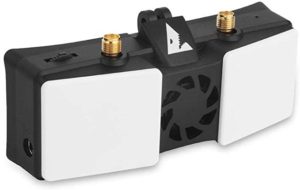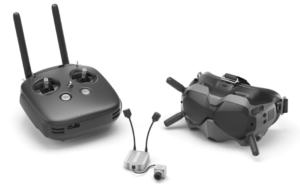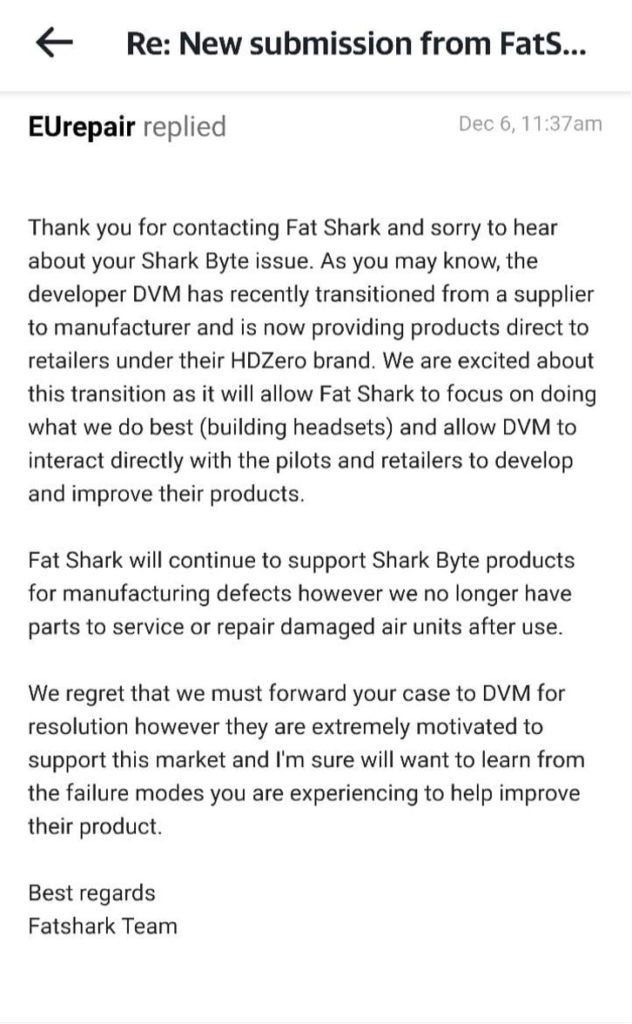DJI Killed Analog. Long Live Analog!
by DRONELIFE Contributor John Saginario
Movers and shakers in the hobby market read the wind and cut ties.

It’s What They Can’t See
When it comes to UAV technology, the hobbyist market has always been an interesting bellwether. It’s where many technologies get their start, where new software and algorithms cut their teeth, and where ideas are transformed for scale.
And then there’s just realizing you sometimes can’t beat the big players at their own game, so you stop trying.
That’s the subtext behind the very recent word from Fat Shark (RedCat Holdings) that it’s dropping most support of its Shark Byte Digital FPV system. For those not aware, prior to its pivot to more commercial interests, Fat Shark was the name (and arguably still is) in FPV goggles. A little over a year ago, after making lots of money selling analog headsets, they decided to put their support behind a digital FPV system that broke the “Standard Definition” barrier into HD. Fresh off releasing their best (and most expensive) goggles to date, the Fat Shark HDO2, they were keen to push a new add-on that promised even more immersive, higher-resolution video than ever before.
 Then DJI swam in and swallowed the entire pond.
Then DJI swam in and swallowed the entire pond.
At flying fields and many local races, DJI FPV goggles are everywhere. For many hobbyists, especially those who fly the typical 5” freestyle quadcopter, it’s practically a requirement.
A few weeks after the news of DJI goggles’ release made the rounds, and YouTubers and reviewers started to swoon over the video quality and relatively low latency, people could not post their own analog goggles and cameras on Facebook Marketplace fast enough.
New pilots just getting into the hobby routinely purchase DJI gear first, and stores regularly sell out. It’s an enthusiasm tempered only by the ongoing global chip shortage which has made new cameras and transmitters more difficult to find.
The same can’t be said for Shark Byte. The chip shortage has affected them, too. Limited stock of products quickly sell out. But adoption has not been nearly as large.
Fire Sale
Leading into the summer of 2021, Fat Shark decided to put its HD video system on a fire sale. Modules that were retailing for $249 were cut down to $99. What little stock was available quickly flew off virtual shelves.
At the time, it felt like an aggressive tactic to take on DJI’s competing digital solution and increase market share. In reality, it now seems Fat Shark saw the writing on the wall, and decided it wasn’t going to fight a fatter whale.
Fast-forward a few months and now users are posting emails from Fat Shark support reps, telling customers they will no longer be supporting most elements of the Shark Byte universe: namely the cameras and VTX’s for sale on their website, that are created by their partner: HDZero.

In fact, they’ve even pulled back support for their own products, only promising help in the event of “manufacturing defects.” So no more support than that.
For its part HDZero, the company behind this technology, has promised to support Shark Byte users now and in the future. It’s also posted messages on social media platforms promising new Shark Byte-compatible hardware and new form factors in 2022.
The Future Bytes
For now, the future of Digital FPV seems a bit less certain if you’re unable or unwilling to buy into the DJI ecosystem. For those that have, the debate has largely already been settled and the future is here.
For tens of thousands of hobbyists who have yet to take the HD plunge or decided to invest in the system backed by their favorite goggle maker, we’re now relying on other, lesser-known companies outside the U.S. to carry the technology forward. Whether it remains viable and competitive remains to be seen.
Read more about FPV goggles, DJI’s FPV drones, and drone racing gear.
 John is an FPV hobbyist and part-time whoop racer. He also enjoys testing new hardware, building drones, staying on top of the latest developments in technology, and writing about UAVs in general. He has 2 kids, 2 dogs and shamefully more quadcopter than he can reasonably count in one sitting.
John is an FPV hobbyist and part-time whoop racer. He also enjoys testing new hardware, building drones, staying on top of the latest developments in technology, and writing about UAVs in general. He has 2 kids, 2 dogs and shamefully more quadcopter than he can reasonably count in one sitting.
Miriam McNabb is the Editor-in-Chief of DRONELIFE and CEO of JobForDrones, a professional drone services marketplace, and a fascinated observer of the emerging drone industry and the regulatory environment for drones. Miriam has penned over 3,000 articles focused on the commercial drone space and is an international speaker and recognized figure in the industry. Miriam has a degree from the University of Chicago and over 20 years of experience in high tech sales and marketing for new technologies.
For drone industry consulting or writing, Email Miriam.
TWITTER:@spaldingbarker
Subscribe to DroneLife here.
https://dronelife.com/2021/12/30/fpv-goggles-dji-killed-analog-long-live-analog-a-hobbyist-view/
 Unmanned Aerial Vehicle The latest drone news
Unmanned Aerial Vehicle The latest drone news

